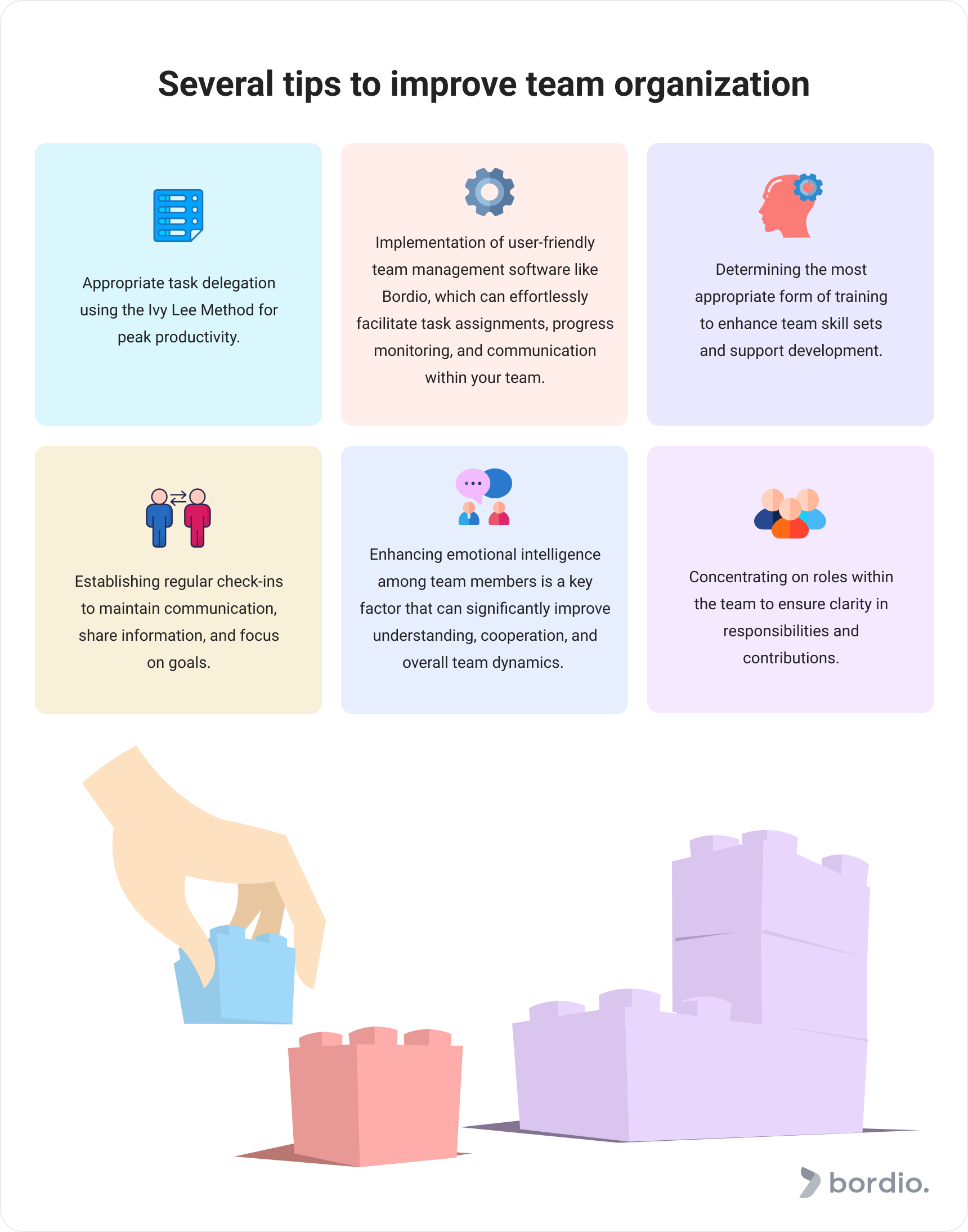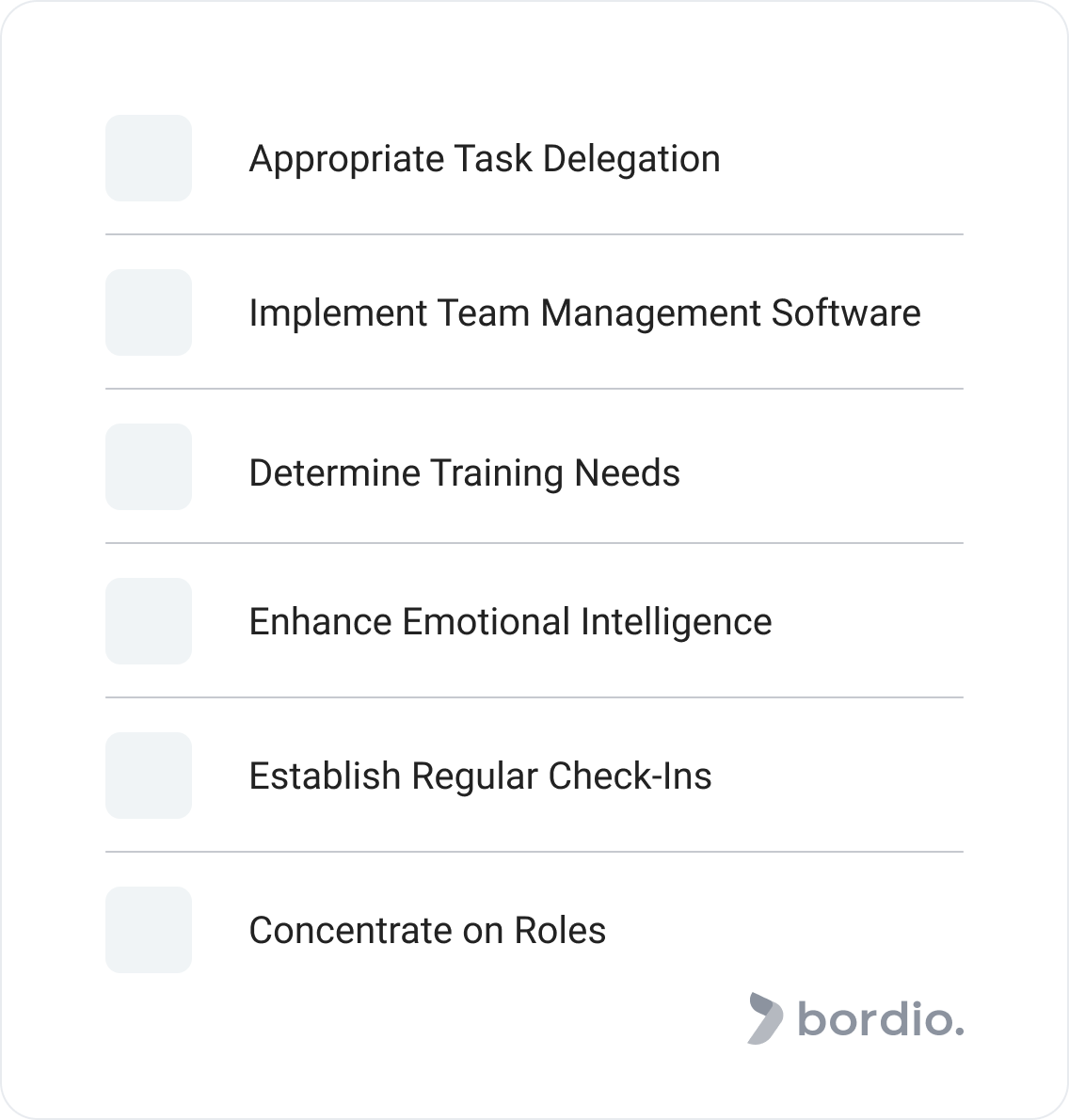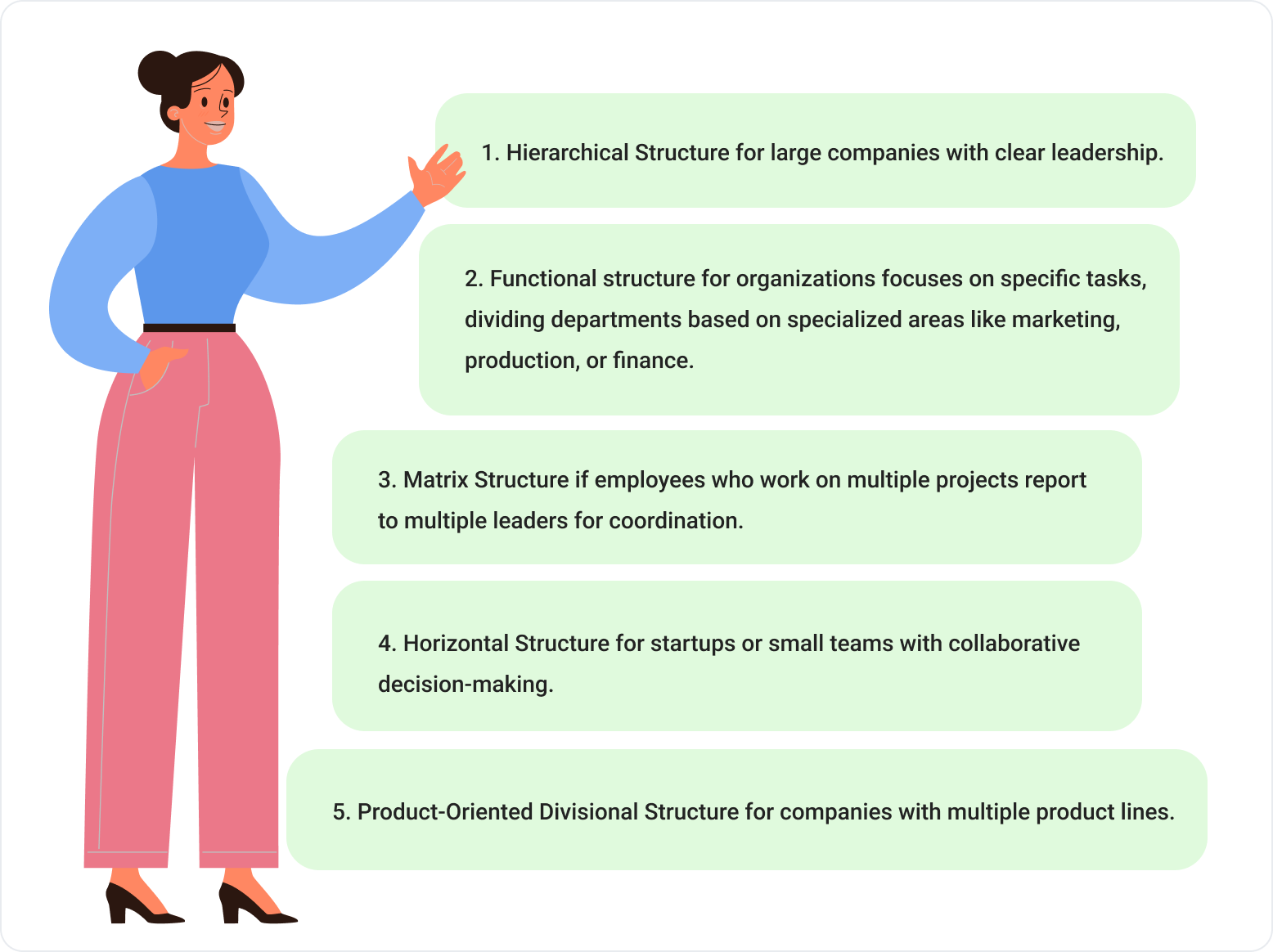Why does organization matter? Even if you have a top-notch business idea and a solid team, that’s just the start. How well you and your team are organized really counts, especially at the beginning. Everyone on your team must pull in the same direction to hit it big, chasing the same dreams and values.
Here’s the thing: when folks with money think about backing a business, they’re not just looking at the idea but also checking out the team that’s going to make it happen. That’s a big deal for businesses. So, we’ll dive into why having your team in good shape matters a lot.
Tip: You might also be interested to learn about the secrets behind a manager’s top-notch organizing skills.
Why is team organization essential?
Well-organized teams streamline their workflow, which means they can complete tasks more efficiently. As a manager, you can introduce new effective methods into the whole team structure and distribute tasks, taking into account the strengths and skills of each team member, which will lead to increased work speed.
Good organization includes setting clear goals, achievable deadlines, and using team collaboration tools or a team project planner. Of course, fast work does not equal high-quality work, but we want to assure you that with good organization, speed will increase, and quality will not suffer either! And what other benefits will the organization bring to your team’s performance and your work?
1. Effective cooperation
Organized teams create an environment where collaboration thrives, and as we mentioned earlier, introducing collaborative team tools is a great idea. Using tools like Bordio, teams will create open communication channels, encouraging team members to exchange ideas easily, leave comments on tasks, and search for solutions together.
This collaborative decision-making process generates better ideas and solutions and builds camaraderie among team members, increasing morale and motivation. Additionally, field experts say that by leveraging diverse perspectives and experiences within the team, they can solve complex problems more effectively.
2. Resource management
Organized teams are innovative about using time, money, and people. They decide what needs to be done first by considering what’s most important and urgent. Then, they ensure those critical tasks are completed before anything else.
Again, we continue the idea about project management tools; it’s good to track and distribute the workload in one place. This optimizes productivity and prevents burnout. Moreover, they can implement strategies to minimize waste, such as avoiding unnecessary expenses, reducing redundant work, or maximizing available resources. Special attention should be paid to time as the most important resource and to improving time management.
3. Flexibility and adaptability
Organized teams are flexible and adapt to changes or unexpected challenges. They understand roles and responsibilities early but are willing to adapt as circumstances evolve.
This flexibility in team structures allows them to pivot quickly when priorities change, new information becomes available, or unexpected obstacles arise. They may have contingency plans, alternative approaches ready to be used, or quick decision-making mechanisms to keep the team on track even in turbulent times.
4. Taking responsibility
The team runs smoothly when everyone knows what they’re supposed to do and is responsible for their work. People understand their job and are dedicated to doing it well. This creates a trusting and productive environment where everyone is motivated to finish tasks on time, do good work, and help each other. When everyone takes responsibility for what they do, the team succeeds and reaches its goals.
Tips for better team organization at work
#1. Do appropriate task delegation
Delegation is one of the important principles of the Ivy Lee Method that increases your team’s productivity to its peak. When forming a team, dividing the work wisely is essential.
You should consider each person’s strengths and assign tasks that match those strengths. Explain the tasks clearly and let people make decisions about their work. Encourage team members to talk openly and contribute ideas during task delegation. This fosters a collaborative environment where everyone feels valued and engaged, especially in the early stages of team formation. It’s like giving everyone a piece of the puzzle they’re good at so the whole picture comes together nicely.
#2. Implement team management software
Many apps and tools are designed to help teams work smoothly together. Implementing team management software will help you assign tasks, monitor progress, and communicate, improving team performance.
Platforms like Bordio are perfect for tracking tasks and planning. With Bordio, you can list all the things that need to be done and track your team’s progress using a project task tracker. You can easily plan when things should get done, assign tasks to different team members, and set deadlines. And if you need to check the calendar to see what’s coming up, Bordio has that covered, too!
Also, team management software should be implemented to facilitate progress reports and enhance team communication. Bordio can help you track individual tasks and the workload of the entire team, promoting transparency and accountability and helping the team stay organized.
#3. Determine the most appropriate form of training
Invest in training programs tailored to the team’s needs to support team development and enhance skill sets. By encouraging continuous learning, team members can grow professionally and contribute more effectively to the team structure. Spending money on training helps everyone do their jobs well and makes the team successful.
Offering opportunities for personal development keeps motivation high. When individuals see themselves getting better, they stay excited about their work. You can organize regular training sessions or workshops to help everyone improve. Investing in training lets people feel empowered to learn new skills and stay interested in their work. When team members feel supported in growing, they’re more likely to stay motivated.
#4. Enhance everyone’s emotional intelligence
Make sure all your team members understand the importance of understanding emotions. Encourage them to get how others feel, to talk straight, and to work well together. Keep in mind that each person has their own way of doing things and what drives them. Honor these differences and see them as chances for everyone to improve and grow. This way, you’ll have a team where everyone feels important and respected.
Good teams communicate a lot. It prevents problems before they arise by keeping everyone informed of changes. Staying in touch helps everyone understand what’s happening, share ideas, and feel they’re working toward the same goal. There are different ways to communicate, but each one is equally important.
Besides talking face-to-face in the office, there can be one-on-one meetings for detailed discussions about ongoing projects and tasks and calls and messages for quick, urgent discussions. These options are also great for managing remote teams. You can use special management platforms: for example, Bordio, besides task management, allows users to leave notes and describe tasks and has a live chat for fast communication. You can discuss task problems or ask questions right within the software, having less chatting but more effective communication without leaving the collaboration platform.
#5. Establish regular check-ins
Working as a team will help make the job run smoother and faster. Create a space where people feel comfortable sharing ideas and working on projects together. Check what your team is doing and how the project is progressing. You can hold regular meetings or brainstorming sessions that everyone can join. A lot of people work on a project together, and it’s much better than doing it alone.
Good communication and information sharing prevent confusion and help everyone focus on the same goals. Don’t be afraid to ask questions! It’s better to ask and make sure than to screw up because we didn’t understand. Asking questions helps us perform better and avoid mistakes.
#6. Concentrate on the roles
Choose your team carefully, picking folks with the right work skills. Don’t just add people without thinking it through. Make sure everyone knows their job. Assign specific tasks and show how they help the team reach its goals.
Make a space where people can freely share ideas and make decisions without delay. Things will run smoothly once everyone knows their role and how they fit into the team.
Be clear about what each person is supposed to do and what’s expected of them. So there’s no confusion, and everyone contributes. It’s like following steps to assemble furniture – every step matters for the final piece. Avoid setting goals that are too high or out of reach. Set realistic goals that can be met within a specific timeframe to prevent everyone from getting frustrated.
Organizational structures for your team: how to choose?
When figuring out how to structure your existing team, consider what your company wants to accomplish and the type of work it does. Also, consider how many people are on your team, how they collaborate, where they’re based, and whether offices are in different locations. Take into account your company’s culture and management preferences. All these factors will help you choose the best way to set up your team for success.
1. Hierarchical structure: This is a classic form of organization in which management comes from the top down. Leaders make decisions that are passed down the chain of command to lower levels. This structure provides organizational clarity and a clear hierarchy of authority and responsibility. A project planning board can be an essential tool in various organizational structures. For example, in a hierarchical structure, it helps to keep everyone informed of tasks and deadlines set by higher management. In a matrix structure, it can assist with coordinating multiple projects and ensuring that different team leaders are aligned.
Example: A big company where top bosses make big decisions that trickle down through management layers. The CEO sets the overall plan in a work management tool, passing it to each new manager and department head, who divide the work among individual team positions.
2. Functional Structure: The company is divided into departments based on specific tasks or abilities. Each department focuses on one market or area, like marketing, production, or finance. This setup helps streamline work in each specialized area.
Example: Picture a factory with different marketing, production, and finance teams. The marketing folks promote things, the production team makes the products, and the finance people handle money matters like budgets and accounting.
3. Matrix Structure: Employees report to multiple team leaders in this structure, allowing them to work on multiple projects simultaneously. This structure promotes a straightforward reporting structure and coordination within the organization.
Example: Software company where workers answer to team leaders and department heads. So, a software developer might work on a project under a project manager’s guidance while reporting to a department head in their area, like coding or design.
4. Horizontal structure: Structure minimizes hierarchy levels and allows teams to self-organize more. All levels of management have access to resources and information, facilitating better communication and rapid decision-making.
Example: Startup where everyone, from top to bottom, works closely together and makes decisions. Engineers, designers, and marketers collaborate and have a say in how things are done. It’s all about teamwork and quick problem-solving.
5. Product-Oriented Divisional Structure: The company is divided into teams, each in charge of a particular product or service. This setup lets you concentrate on enhancing and refining specific products.
Example: An electronics company is split into divisions for different products, such as mobile devices like phones, tablets, and laptops. Each division has a team that designs, makes, and sells its products. Thus, the company can focus on each product line separately, putting resources and skills where they’re needed most.
Final thoughts on organizing teams at work
Good team organization is essential for any business to succeed. Think of it like a smooth-running machine: when a team is well-organized, it can achieve great things like a perfectly functioning machine. Every part of team development and organization, like assigning tasks and helping people work together, is crucial for ensuring the team gets stuff done and develops new ideas.
Investing in the right tools, like time management software, and giving proper training are super important to help each team leader and member do their best. It’s also crucial to know what each role and person is good at so they can contribute effectively. Understanding each other’s feelings and how we work is just as crucial. When everyone feels valued and understood, it creates a positive vibe where people can shine.
Organizing a team’s work well means thinking ahead and being ready to adapt. When teamwork, flexibility, and communication are priorities, businesses can grow and develop new ideas that make a real difference.















